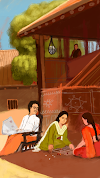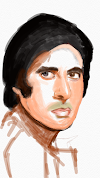Exploring European Food Habits - A Friendly Chat
You: Hi Henry! I’m having lunch right now, but honestly, I don’t know much about cooking, ordering food online, or even making something simple at home. Can we talk about food in Europe? What’s it like?
Henry: Of course! European food is incredibly diverse. Each country has its own unique dishes and traditions. What are you eating right now?
You: Just some rice and curry. What about you? What do people in Europe typically eat for lunch?
Henry: Lunch varies a lot, but many countries keep it simple. In France, it could be a baguette sandwich with cheese or ham. In Italy, it might be a light pasta dish or a salad. In Northern Europe, soups and stews are popular.
You: What’s your favorite European food?
Henry: That’s a tough one! I’d say Italian lasagna or Spanish paella. Both are flavorful and hearty. Have you heard of them?
You: I’ve heard of lasagna, but how is paella made?
Henry: Paella is a Spanish dish made with rice, saffron, and a mix of seafood, chicken, or rabbit. Vegetables like bell peppers and green beans are often added. It’s cooked in a large pan and is perfect for sharing.
You: Speaking of vegetables, what are the common ones used in European cooking?
Henry: Potatoes, tomatoes, onions, carrots, and bell peppers are staples. In Mediterranean countries, zucchini, eggplants, and olives are also common.
You: What about drinks? Do people drink juices or something else with meals?
Henry: Juices are popular, especially orange juice during breakfast. For other meals, water, wine, or beer is common. In Germany, they even have apple juice mixed with sparkling water!
You: What’s a typical European breakfast like?
Henry: It depends on the country. In France, you might have croissants and coffee. In the UK, there’s the "full English breakfast" with eggs, sausages, bacon, beans, and toast. In Scandinavia, it’s often rye bread with cheese or smoked fish.
You: And dinner? Is it heavy or light?
Henry: Dinner is usually the main meal. In Italy, it could be pasta or risotto. In Germany, it might be schnitzel with potatoes. In Spain, they eat late and often have tapas – small plates of different foods.
You: What about bread-based dishes?
Henry: Bread is huge in Europe! In France, there’s baguette and brioche. In Italy, there’s focaccia and ciabatta. In Eastern Europe, you’ll find hearty rye bread. Sandwiches are a universal favorite!
You: Are eggs used in many dishes?
Henry: Absolutely. Eggs are versatile – think omelets, quiches, and pastries like éclairs. In Spain, there’s the tortilla española, a potato and egg omelet.
You: What about meat? Do Europeans eat a lot of chicken, mutton, or other types?
Henry: Chicken is very common, especially roasted. Mutton and lamb are popular in the UK and Greece. Pork is widely used – think German sausages or Spanish jamón. Beef is also popular, especially in steaks or stews.
You: If I were to visit Europe, how should I prepare for the food habits?
Henry: Be ready to try new things! Breakfast is usually light, lunch can be simple or elaborate, and dinner is often a social event. Bread and cheese are everywhere, and desserts are a must-try – from Italian tiramisu to Austrian strudel!
You: What are some special occasion foods in Europe?
Henry: Special occasions bring out amazing dishes! In Italy, there’s panettone during Christmas. In Germany, roast goose is popular for Christmas, while in France, foie gras and bûche de Noël (a yule log cake) are festive favorites.
You: Are there any unusual or lesser-known dishes I should try?
Henry: Definitely! In Sweden, there’s surströmming, a fermented fish. In Scotland, haggis is a savory pudding made with sheep’s offal. And in Hungary, lángos is a deep-fried flatbread often topped with sour cream and cheese.
You: What are the most common herbs and spices in European cooking?
Henry: Basil, thyme, rosemary, and parsley are common in Mediterranean cuisines. Dill is popular in Eastern Europe. Paprika is a must in Hungary, while nutmeg and cloves are often used in Northern Europe.
You: How about desserts? What are the must-try European sweets?
Henry: Oh, there are so many! France has crème brûlée and macarons. Italy offers gelato and cannoli. Austria’s Sachertorte is a famous chocolate cake, and Belgium is known for its waffles and chocolates.
You: What’s the role of cheese in European cuisine?
Henry: Cheese is huge! France has hundreds of varieties like brie and camembert. Italy has parmesan and mozzarella. Switzerland is famous for fondue, and the Netherlands has gouda and edam. Cheese is used in cooking, snacking, and even desserts!
You: Wow, this has been so enlightening, Henry! I didn’t realize European food was so diverse. Thanks for sharing all this.
Henry: My pleasure! Food is a great way to learn about different cultures. Let me know if you have more questions or need tips when you plan your trip!


















0 Comments